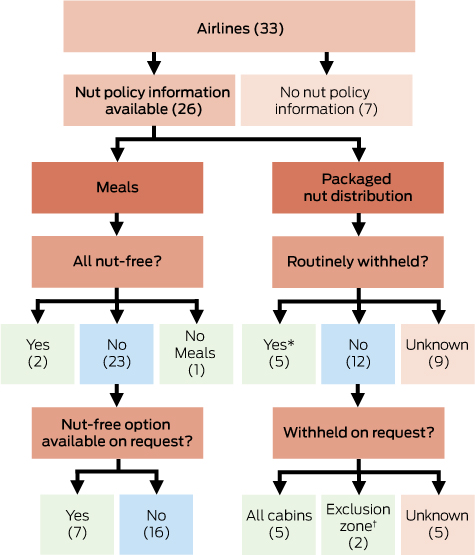Australian flights carry 90 million passengers each year.1 About 1–2% of passengers have documented food allergies, of whom 2–10% report having experienced allergic reactions during air travel.2,3
Peanut and tree nut allergies are among the most serious of food allergies, and typically persist for life.4 The cornerstone of managing a food allergy is strict avoidance of the allergen. Should anaphylaxis occur, an intramuscular adrenaline injection may be life-saving.
During June and July 2015, we conducted a telephone and website survey of all domestic and international airlines that fly from Melbourne Tullamarine Airport to assess public access to airline nut allergy policies, the availability of nut-free meals and the ability to restrict the distribution of packaged nuts, and the in-flight availability of emergency adrenaline.
Of 33 airlines, 20 (61%) had accessible telephone information about a nut allergy policy, and this information was published on the websites of 20 airlines (61%). Telephone and website advice was discordant for three airlines, in that the customer service representatives advised that all nut allergies could be accommodated, but the website indicated that this applied only to peanuts.
Nine airlines (27%) offered nut-free meals, two routinely and seven on request (Box). For the other airlines, nut-allergic passengers would need to fast (only practical on short domestic routes) or bring their own food.
Twelve airlines (36%) could restrict the distribution of packaged nuts if requested, either totally or within an exclusion zone comprising the affected passenger’s row and the rows immediately in front of and behind them (Box). Four airlines (12%) could both offer a nut-free meal and restrict the distribution of packaged nuts.
People consuming packaged nuts place nut-allergic neighbours at risk of physical contact with nuts and accidental ingestion. Requesting nearby passengers not to consume nuts and wiping tray tables may reduce this risk.2 It is unclear whether nut-allergic individuals are at risk from airborne nut proteins, but instances of allergic reaction following such exposure have been reported.5
Only one airline confirmed that emergency adrenaline was available on all flights.
The diverse approaches by airlines to nut allergies reflect the lack of clear evidence supporting any specific policy. Airlines could nevertheless improve the access to relevant information. Given the discordant advice provided in some instances, the critical distinction between peanuts and tree nuts should be emphasised during customer service training. Carrying emergency adrenaline on all flights would seem prudent in light of the reported frequency of food allergy reactions.
We contacted only airlines flying from a single Australian airport, so that our survey is a representative sample of the industry rather than an exhaustive investigation. Telephone information from each airline was based on a single call, and the advice we received was current at the time of our telephone enquiries or website visit; in the meantime, airlines may have updated their policies.
We recommend that nut-allergic individuals contact airlines before travelling, develop an allergy management plan with their doctors, carry their own emergency medical supplies, and consider bringing their own food. Airlines should make their nut allergy policies more accessible and consider carrying emergency adrenaline on all flights.
Provenance: Not commissioned; externally peer reviewed.
Received 3 April 2016, accepted 23 June 2016
- 1. Australian Government Department of Infrastructure and Regional Development. Domestic aviation activity; International airline activity. BITRE [website]. https://bitre.gov.au/statistics/aviation/domestic.aspx; https://bitre.gov.au/statistics/aviation/international.aspx (accessed Mar 2016).
- 2. Greenhawt M, MacGillivray F, Batty G, et al. International study of risk-mitigating factors and in-flight allergic reactions to peanut and tree nut. J Allergy Clin Immunol Pract 2013; 1: 186-194.
- 3. Comstock S, DeMera R, Vega L, et al. Allergic reactions to peanuts, tree nuts, and seeds aboard commercial airliners. Ann Allergy Asthma Immunol 2008; 101: 51-56.
- 4. Bégin P, Paradis L, Paradis J, et al. Natural resolution of peanut allergy: a 12-year longitudinal follow-up study. J Allergy Clin Immunol Pract 2013; 1: 528-530.
- 5. Sicherer S, Furlong T, DeSimone J, et al. Self-reported allergic reactions to peanut on commercial airliner. J Allergy Clin Immunol 1999; 104: 186-189.






No relevant disclosures.